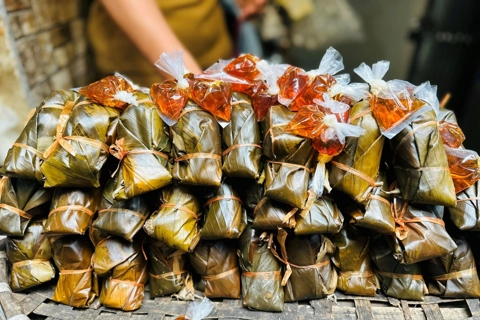Life
To He artisans strive to promote rare surviving Vietnamese traditional toy
Nov 08, 2014 / 04:22 PM
Sometimes while wandering Hanoi streets, one can see vendors of `To He`, a traditional toy manually made with glutinous rice powder. Without any noisy advertisement, `To He` vendors walk across Hanoi streets and silently attract the attention of passers-by.

Magic came out from skilled hands
With simple tools including a tray of glutinous rice powder in various colours, a small comb, a bunch of sticks, and a spongy box to display their products, To He artisans can knead many shapes thanks to their skilled hands and creativity.
To He artisans not only draw the interest of children, but adults as well who enjoying waiting and looking at the way beautiful flowers, funny animals or popular cartoon characters are gradually created by the artisans.
To He craft making originated from Xuan La Hamlet, Phuong Duc Commune, Phu Xuyen District in Hanoi more than 300 years ago. At first, the craft was a way for the villagers to spend their spare time.
They steamed grinded glutinous rice and then dyeing it with powder. There are seven basic colours of To He ─ green, blue, red, purple, yellow, white and black ─ which are made from natural and edible ingredients, including gac fruit to produce red, vegetables for green and turmeric for yellow.
The soft and colourful flour made it easy for them to shape cute little things. In the past, the product was then pinned on the top of a small horn, which generated sounds like “to… te…” when it was whistled. As time went on, the toy was named ‘To He’ as a play on the sound “to…te…”
Tran Van Mien from Xuan La hamlet has devoted most of his life to To He making. In less than five minutes, Mien can produce a colourful horse requested by a young couple.
Struggling to find new way for development
According to Mien, To He craft can generate remarkable income for the craftsmen, earning an average of VND 200,000 – VND300,000 a day by selling their products during festivals.
However, the craft experienced many ups and downs as it faced the threat of fierce competition from foreign toys, particularly Chinese toys, which are much cheaper and diversified in designs and colours.
Like other traditional craft villages, Xuan La villagers encounter obstacles to increasing output for their products and widely advertise the toys.
To He cannot be widely introduced outside the traditional communal market due to its traditional ingredient; rice power makes it easy for the craftsmen to knead but on the other hands, it causes the toy’s appearance to quickly get mouldy, dry and split. A To He product can be kept for three to 30 days, depending on the craftsmen’s skill and weather condition.
The obstacle urged the craftsmen to try experiments to seek new suitable ingredient.
Mrs Dien’s family is the first and the only one in Phu Xuyen to try to make To He using tapioca flour. The huge advantage of the paste is a shelf-life of up to one year, without any threat of moulding.
However, it takes the artisans longer to complete their crafts with tapioca flours as it needs to be boiled in water before being brought the market. With this technique the craftsmen can only provide premade crafts, diluting the uniqueness of To He as customers cannot request custom designs.
In the same move to advertise their products, the To He artisans also try to catch up with the increasing demand of customers, particularly children. In the past, To He used to be in the shape of fruits, flowers, and main characters in the ‘Journey to the West’ TV series. Nowadays, the artisans update children’s favourite cartoons in case they have orders on making characters from these films.
In the past, To He was made and sold only during festivals, particularly Tet (traditional Lunar New Year) holiday and Mid-Autumn festival. Nowadays, the toy is regularly present in most traditional festivals, and public places, such as squares, parks, gardens.
To He artisans hope for support and involvement from relevant agencies to provide them with directions for further development as well as from scientists to find an advanced recipe for To He making, in a bid to preserve and uphold one of the rare surviving traditional toys of Vietnam.
With simple tools including a tray of glutinous rice powder in various colours, a small comb, a bunch of sticks, and a spongy box to display their products, To He artisans can knead many shapes thanks to their skilled hands and creativity.
To He artisans not only draw the interest of children, but adults as well who enjoying waiting and looking at the way beautiful flowers, funny animals or popular cartoon characters are gradually created by the artisans.
To He craft making originated from Xuan La Hamlet, Phuong Duc Commune, Phu Xuyen District in Hanoi more than 300 years ago. At first, the craft was a way for the villagers to spend their spare time.
They steamed grinded glutinous rice and then dyeing it with powder. There are seven basic colours of To He ─ green, blue, red, purple, yellow, white and black ─ which are made from natural and edible ingredients, including gac fruit to produce red, vegetables for green and turmeric for yellow.
The soft and colourful flour made it easy for them to shape cute little things. In the past, the product was then pinned on the top of a small horn, which generated sounds like “to… te…” when it was whistled. As time went on, the toy was named ‘To He’ as a play on the sound “to…te…”
Tran Van Mien from Xuan La hamlet has devoted most of his life to To He making. In less than five minutes, Mien can produce a colourful horse requested by a young couple.
Struggling to find new way for development
According to Mien, To He craft can generate remarkable income for the craftsmen, earning an average of VND 200,000 – VND300,000 a day by selling their products during festivals.
However, the craft experienced many ups and downs as it faced the threat of fierce competition from foreign toys, particularly Chinese toys, which are much cheaper and diversified in designs and colours.
Like other traditional craft villages, Xuan La villagers encounter obstacles to increasing output for their products and widely advertise the toys.
To He cannot be widely introduced outside the traditional communal market due to its traditional ingredient; rice power makes it easy for the craftsmen to knead but on the other hands, it causes the toy’s appearance to quickly get mouldy, dry and split. A To He product can be kept for three to 30 days, depending on the craftsmen’s skill and weather condition.
The obstacle urged the craftsmen to try experiments to seek new suitable ingredient.
Mrs Dien’s family is the first and the only one in Phu Xuyen to try to make To He using tapioca flour. The huge advantage of the paste is a shelf-life of up to one year, without any threat of moulding.
However, it takes the artisans longer to complete their crafts with tapioca flours as it needs to be boiled in water before being brought the market. With this technique the craftsmen can only provide premade crafts, diluting the uniqueness of To He as customers cannot request custom designs.
In the same move to advertise their products, the To He artisans also try to catch up with the increasing demand of customers, particularly children. In the past, To He used to be in the shape of fruits, flowers, and main characters in the ‘Journey to the West’ TV series. Nowadays, the artisans update children’s favourite cartoons in case they have orders on making characters from these films.
In the past, To He was made and sold only during festivals, particularly Tet (traditional Lunar New Year) holiday and Mid-Autumn festival. Nowadays, the toy is regularly present in most traditional festivals, and public places, such as squares, parks, gardens.
To He artisans hope for support and involvement from relevant agencies to provide them with directions for further development as well as from scientists to find an advanced recipe for To He making, in a bid to preserve and uphold one of the rare surviving traditional toys of Vietnam.








